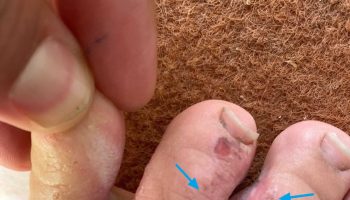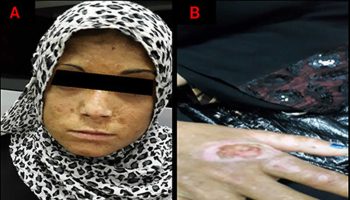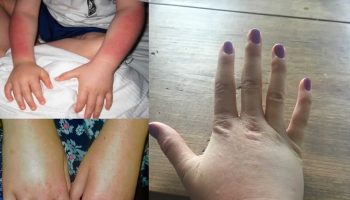Sulfite sensitivity
A sulfite sensitivity is when your body reacts to consuming sulfites. Sulfite (sulphite) sensitive people may have a similar reaction as those with a food allergy. Sulfites can trigger asthma and symptoms of an anaphylaxis (a severe potentially life-threatening allergic reaction). Sulfite sensitivity occurs mostly in people who have asthma (asthmatics) and may occur in a small number of non-asthmatic individuals 1, 2. Approximately 5–10% of people living with asthma are thought to have sulfite sensitivity. Common symptoms are wheezing, chest tightness and coughing. In people with asthma, reactions to sulfites are more likely when their asthma is not well controlled. Numerous studies confirm that sensitivity to sulfites is common and after oral intake, may present as asthmatic attacks in people suffering from asthma, but also as urticaria and angioedema in other individuals. Asthmatic symptoms were shown to be induced by exposure to sulfite in orange drinks in a patient-based study 3. Most studies report a 3-10% prevalence of sulphite sensitivity among asthmatic subjects following ingestion of these additives 4. Also, exposure to sulfite through various routes has been linked to a range of adverse clinical effects in sensitive individuals, ranging from dermatitis to life-threatening anaphylactic and asthmatic reactions 2. Most sulfite sensitivities are not true allergic reactions and to date the mechanisms of sulfite sensitivity remain unclear and likely due to various biological reactions, depending on the individual genetic background.
Sulfite (SO32–) also called sulphites, is the name given to a class of commonly used preservatives (E 220–228) that reduce spoilage, act as antioxidants, and prevent fruit and vegetable from going brown 5. Sulfites are used as antioxidants for the improvement of food quality and appearance as well as extending shelf life. Sulfites are effective against most bacteria and are widely used antimicrobial agents in the production of meats, in fruit products, fruit juices, potatoes, biscuits and in alcoholic beverages. Thus, sulfites are used in a variety of foods, which have different physical (pH) and ingredients composition, which may influence their fate: stability, solubility, availability and loss during processing. Sulfites are also used extensively in the pharmaceutical industry 6 and have a number of industrial uses. Some common names include sulfur dioxide (SO2) or E 220, sodium sulfite (E 221), sodium bisulfite (E 222), sodium metabisulfite (E 223), potassium metabisulfite (E 224), calcium sulfite (E 226), calcium bisulfite (E 227) and potassium bisulfite (E 228) 7. Sulfites may be present in baked goods, condiments, shrimp, certain wines (white wine usually more than red wine) and beer. Sulfites are present in dried fruits in high quantities. Since 1986, the US Food and Drug Administration (FDA) has banned them in most fresh fruits, vegetables, and salad bars 8. The FDA requires labeling on any food or beverage with greater than 10 parts per million of sulfite preservatives 8. Despite the introduction of these regulations, there continued to be sporadic reports of serious adverse effects following unintended ingestion of sulfites. The potentially severe nature of sulfite sensitivities is highlighted by a number of reports of life-threatening reactions to these additives 9.
If you believe you may have a sulfite sensitivity, it is important that you see a clinical immunology/allergy specialist who will assess you for sulfite sensitivity so that an appropriate management plan can be developed. However, there is currently no reliable blood or allergy skin test to test for sulfite reactions.
Endogenous sulfites can be generated as a consequence of the body’s normal processing of sulfur-containing amino acids and that sulfites may occur as a consequence of fermentation and are naturally present in a number of foods and beverages.
Sulfa drugs, antibiotics and other medicines that contain a sulfonamide molecule, are not the same thing as sulfites. Some people will have allergic reactions to sulfonamide containing medications such as sulfonamide antibiotics. This is a very different condition from sulfite sensitivity.
Sulfates are salts of sulfuric acid and are present in many medicines, supplements, and personal care products – they are not the same thing as sulfites or sulfa drugs.
Sulfur or sulphur is an element that is essential for life, and is found in sulfites, sulfates, and sulfonamides, but by itself is not responsible for the reactions people have to these other molecules. Elemental sulfur can rarely cause problems if inhaled.
People who react to sulfites do not need to avoid sulfates or sulfur.
Some medications have a sulfate component (such as morphine sulfate), and most soaps and shampoos contain compounds such as sodium lauryl sulfate. These are not allergenic and do not cause reactions in sulfite-sensitive people. Elemental sulfur which is used in gardening may cause difficulty breathing if inhaled, but is not usually a specific problem for sulfite-sensitive people.
People with relatively mild reactions to sulfites, such as mild wheezing, should carry asthma relievers when eating away from home. People who are at risk of more serious reactions should have an Action Plan for Anaphylaxis and carry at least one prescribed adrenaline (epinephrine) injector (such as EpiPen®, Anapen®).
Do people who react to sulfites need to avoid sulfates or sulfur?
No. Some medications have a sulfate component (such as morphine sulfate), and most soaps and shampoos contain compounds such as sodium lauryl sulfate. These are not usually allergenic and do not cause reactions in sulfite-sensitive people. Elemental sulfur which is used in gardening may cause difficulty breathing if inhaled but is not usually a specific problem for sulfite-sensitive people.
Is sensitivity to sulfites is a different condition from sulfonamide antibiotic allergy?
Yes. Allergic reactions to sulfonamide antibiotics are very different to sulfite sensitivity.
A person that is allergic to one sulfonamide antibiotic, is at risk of reacting to other sulfonamide antibiotics. Examples of sulfonamide antibiotics:
- Sulfamethoxazole that is used in combination with trimethoprim.
- Less commonly used sulfonamide antibiotics such as sulfadiazine (tablets, injections or creams), sulfadoxine (for malaria), and sulfacetamide antibiotic eye drops.
- Sulfasalazine (Salazopyrin, Pyralin), that is used in inflammatory bowel disease or arthritis, and is a combination sulfapyridine (a sulfonamide antibiotic) and a salicylate.
Sulfonamide antibiotics can cause allergic reactions that range from a mild rash to a severe blistering rash, through to anaphylaxis, which is the most severe type of allergic reaction.
Are low or no sulfite wines and beers available?
Some wine makers and brewers produce wines and beers which state that they do not add sulfites. However, there are many technical reasons related to wine making and brewing, which may mean that very low levels of sulfites are still present, even when not deliberately added.
Sulfites are generally found at higher levels in cask wine than bottled wine, and are at much higher concentrations in white wine than red wine, which is preserved by natural tannins.
What is sulfite sensitivity?
A sulfite sensitivity is when the body reacts to consuming sulfites. Sulfite (sulphite) sensitive people may have a similar reaction as those with a food allergy. Sulfites can trigger asthma and symptoms of an anaphylactic reaction. Many people who have asthma may also have a sulfite sensitivity. An allergist can confirm sulfite sensitivity. In this case, sulfites need to be avoided.
The mechanism for sulfite adverse reactions
- Inhaling sulfur dioxide (SO2) may cause reflex contraction of the airways. This mechanism may explain the rapid onset of symptoms when drinking liquids like beer or wine, when SO2 is inhaled during the swallowing process.
- Some people with asthma who react to sulfites have a partial deficiency of the enzyme sulfite oxidase which helps to break down sulphur dioxide.
- Some people have positive skin allergy tests to sulfites, indicating IgE-mediated allergy.
Given the wide variations in symptoms, in the severity of reactions, and in the sensitivities of individuals to different forms of sulfite, it is unlikely that any single mechanism can explain all reactions to the sulfite additives.
A number of potential mechanisms that might explain asthmatic reactions to the sulfites have been postulated, although the mode of exposure is a confounding factor 10. Nebulized bisulfite solutions, acidified metabisulfite solutions, encapsulated metabisulfite and sulfite containing food or drinks may or may not provoke reactions in the same individual, and the types of reactions and concentrations of sulfite that provoke reactions may vary widely with different forms of exposure. Inhalation of sulfur dioxide (SO2), generated from ingested sulfites in the warm acidic environments of the mouth and stomach, may cause respiratory symptoms. Although nebulized metabisulfite was also thought to cause bronchoconstriction through generation of sulfur dioxide (SO2) in the airways 11, airway responsiveness to acidic metabisulfite solutions and sulfur dioxide (SO2) were not significantly related 12.
Some studies have suggested that sulfites may stimulate the parasympathetic system, with bronchoconstriction being mediated by a cholinergic pathway 13. The enzyme sulfite oxidase oxidizes sulfite to sulphate, and it was suggested that inadequate activity of this enzyme may result in excessive accumulation of sulfite, resulting in cholinergic mediated bronchoconstriction in some individuals 14. The release of histamine and other mediators as a consequence of mast cell degranulation through IgE or non-IgE mediated mechanisms has also been suggested as a possible mechanism in some individuals 15. There is some evidence supporting a role for prostaglandins in sulfite induced asthma 16, and the inhibition of bronchoconstriction by leukotriene receptor antagonists, in asthmatic subjects exposed to sulfur dioxide, suggests a possible role for leukotrienes 17.
What are other names for sulfites?
Sulfites can have many other names, such as:
- Potassium bisulphite
- Potassium metabisulphite
- Sodium bisulphite
- Sodium dithionite
- Sodium metabisulphite
- Sodium sulphite
- Sulphur dioxide
- Sulphurous acid
- Sulphites
- Sulfiting or sulphating agents.
Are sulfites safe to eat?
Yes, for most people. However, some people have sulfite sensitivity and may react to sulfites with allergy-like symptoms.
In 1986, the Joint FAO/WHO Expert Committee on Food Additives (JECFA) allocated a group acceptable daily intake (ADI) of 0–0.7 mg sulfur dioxide (SO2) equivalent/kg body weight per day for sulfur dioxide and sulfites. In 1994, the Scientific Committee on Food (SCF) similarly allocated a group acceptable daily intake of 0–0.7 mg sulfur dioxide equivalent/kg body weight per day
based on pigs and rats studies.
Based on the available genotoxicity data, the European Food Safety Authority Panel considered that the use of sulfur dioxide and sulfites (sodium sulfite, sodium bisulfite, sodium metabisulfite, potassium metabisulfite, potassium bisulfite, calcium sulfite and calcium bisulfite) as food additives did not raise a concern with respect to genotoxicity 7.
What foods and drinks have sulfites?
Sulfites preserve many drinks and foods. In many countries it is illegal to add sulfites to foods like fresh salads or fruit salads, or to meats like minced meat or sausage meat.
The addition of sulfites to beer and wine is permitted in most countries.
The following is a list of the most common sources of accidental exposure to sulfites.
Foods and drinks that often contain sulfites include:
- Canned and frozen fruits and vegetables
- Fruit and vegetables juices
- Bottled soft drinks and fruit juice, cordials, cider, beer, wine (including sparkling wine) and instant tea
- Commercial preparations of lemon and lime juice, vinegar, grape juice
- Fruit fillings and syrups, jams, jellies and other preserves
- Dried fruits and vegetables, like dried apricots, fruit bars, coconut, raisins and sweet potato. Dried apricots, and sometimes grapes will be transported with sachets of the sulfite containing preservative. Dried sultanas do not normally contain sulfites.
- Cereal, cornmeal, cornstarch, crackers and muesli
- Dehydrated, mashed, peeled and pre-cut potatoes, including French fries
- Dried potatoes, gravies, sauces and fruit toppings, maraschino cherries, pickled onions, sauerkraut, pickles, maple syrup, jams, jellies, biscuits, bread, pie and pizza dough
- Salads and fruit salads. Restaurant may add sulfites to preserve their color of salads and fruit salads.
- Crustaceans. Sulfur powder may be added on top of crustaceans to stop them discoloring.
- Tomato pastes, pulps and purees
- Condiments like horseradish, ketchup, mustard, pickles and relishes
- Vinegar and wine vinegar
- Bottled lemon and lime juices and concentrates
- Alcoholic and non-alcoholic wine, beer and cider. Sulfites are generally found at higher levels in cask wine than bottled wine, and are at much higher concentrations in white wine than red wine, which is preserved by natural tannins.
These foods may also contain sulfites:
- Baked goods, including granola bars (especially with dried fruits)
- Deli meats, mince meat, hot dogs and sausages. Sulfites are sometimes added illegally to mincemeat or sausage meat.
- Dressings, gravies, sauces and soups
- Dehydrated fish, crustaceans and shellfish
- Noodle and rice mixes
- Soy products
Other items that may contain sulfites include:
- Gelatin or pectin
- Sweeteners like dextrose, glucose solids and syrup and molasses.
Sulfites are not allowed on fresh vegetables and fruits (except sliced potatoes and raw grapes). They are also not allowed on pre-packaged meat, poultry and fish (other than tuna and crustaceans).
In United States, sulfites must be listed on the package label (except for alcohol). Stricter US guidelines require that sulfite-containing products are clearly labelled. The ingredient list will say “contains: sulfites / sulphites” if it contains this ingredient.
Medical and cosmetic uses of sulfites
- Topical medication: Some eye drops and creams. Topical anti-fungal and corticosteroid creams and ointments (e.g. Trimovate®, Timodine®, Aureocort®, Aureomycin®, Nizoral®, Nystatin®, Lustra®, Psoradrate®), adrenaline, isoprenaline, isoproterenol, isoetharine, phenylephrine, dexamethasone and injectable corticosteroids, dopamine, local anaesthetics, propofol, aminoglycoside antibiotics, metoclopramide, doxycycline and vitamin B complex
- Oral medication: No adverse reactions to sulfites have been reported from swallowed medication that might have been contaminated with sulfites.
- Injectable medication: Adrenaline (epinephrine), isoprenaline, phenylephrine, dexamethasone and some other injectable corticosteroids, dopamine, local anaesthetics/dental anaesthetics containing adrenaline and aminoglycoside antibiotics are the most common potential sources of exposure. Even in people with serious sulfite sensitivity, the benefit of adrenaline is considered to outweigh any theoretical risk from sulfites in an emergency.
- Cosmetic uses of sulfites: hair colors and bleaches, home permanent solutions, skin fading/lighteners, false tan lotions, anti-ageing creams and moisturizers, facial cleansers, around-eye creams, body washes/cleansers, hair sprays, perfumes, blush, bronzers/highlighters
Should I avoid eating sulfites?
Only if you have sulfite sensitivity. You can prevent a sulfite reaction by avoiding all food and products with sulfites. Keep these helpful tips in mind:
- Look at the ingredients list and avoid foods that say “contains: sulfites / sulphites”
- Avoid foods that say “may contain” or “may contain traces” of sulfites on the label.
- If you are unsure if a product contains sulfites, contact the manufacturer. Many food packages have contact information on them.
- Don’t take chances. Avoid foods that do not have a clear ingredient list. This includes avoiding imported products, as they do not always have an accurate food label.
- Be informed.
- Avoid bulk foods where the ingredient lists are not clear and may have come in contact with other bulk items containing sulfites.
- When eating out, ask if sulphite-containing foods are used. Call ahead if you can.
Ask at the grocery store if the sliced potatoes, raw grapes and pre-packaged tuna and crustaceans contain sulfites.
Sulfite sensitivity symptoms
Exposure to sulfites has been reported to induce a range of allergy like reactions (intolerances) in sensitive individuals, ranging from dermatitis, urticaria (hives), allergic rhinitis (hay fever), flushing, hypotension, abdominal pain and diarrhea to life-threatening anaphylactic and wheezing in people with asthma 18. Asthma symptoms are the most common adverse reactions. Adverse reactions to sulfites can also occur when there is no preceding history of asthma. Sulfite-induced asthmatic symptoms range from mild in some individuals, to very severe in others, and in some individuals these reactions can be life threatening 19.
Anaphylaxis to sulfites is very rare. Symptoms include flushing, fast heartbeat, wheezing, hives, dizziness, stomach upset and diarrhoea, collapse, tingling or difficulty swallowing.
Exposure to the sulfites arises mainly from the consumption of foods and drinks that contain these additives; however exposure may also occur through the use of pharmaceutical products, as well as in occupational settings.
Although the literature regarding the prevalence of skin reactions to the sulfites is somewhat limited, studies suggest that somewhere between 1 and 5% of those patch tested may demonstrate skin sensitivities to these additives 20.
Reports in the literature describe adverse dermatological responses following exposure to cosmetics, such as facial cosmetic creams 21, hair dyes 22 and false tanning lotion 20.
In addition, topical medications, such as antifungal 23 and haemorrhoid creams 24 and eye drops 25 have been associated with the elicitation of skin symptoms. Similarly, a wide range of occupational exposures have also been linked with adverse skin reactions to the sulfites 26.
Do sulfites cause headaches and migraines?
It’s possible. People who suffer from migraines are often told to avoid sulfites as they may act as a trigger. More research is needed to understand the link between sulfites and migraines. If you think sulfites may be the cause of your migraines, take note of what you ate and drank before your migraine started and talk to your doctor.
Sulfite sensitivity diagnosis
Most people with sulfite sensitivity do not have positive allergy tests and there is currently no reliable blood or skin allergy test for sulfite intolerances.
A food challenge under supervision of a clinical immunology/allergy specialist may confirm or exclude sensitivity
Sulfite sensitivity treatment
Sulfite avoidance is safest. Test strips to test food for the presence of sulfites are available in some countries, but are not 100% reliable.
People with relatively mild reactions such as mild wheezing should carry asthma puffers when eating away from home. People with more serious reactions should have an Action Plan for Anaphylaxis, and carry a prescribed adrenaline autoinjector.
There is no proven way of desensitization or immunotherapy to reduce the severity of sulfite sensitivity.
- Song A., Lin F., Li J., Liao Q., Liu E., Jiang X., Deng L. Bisulfite and sulfite as derivatives of sulfur dioxide alters biomechanical behaviors of airway smooth muscle cells in culture. Inhal. Toxicol. 2014;26(3):166–174. https://doi.org/10.3109/08958378.2013.872211[↩]
- Vally, H., Misso, N.L.A. and Madan, V. (2009), Clinical effects of sulphite additives. Clinical & Experimental Allergy, 39: 1643-1651. https://doi.org/10.1111/j.1365-2222.2009.03362.x[↩][↩]
- Freedman BJ. Asthma induced by sulphur dioxide, benzoate and tartrazine contained in orange drinks. Clin Allergy. 1977 Sep;7(5):407-15. doi: 10.1111/j.1365-2222.1977.tb01471.x[↩]
- Vally H, Misso NL, Madan V. Clinical effects of sulphite additives. Clin Exp Allergy. 2009;39(11):1643-1651. doi:10.1111/j.1365-2222.2009.03362.x[↩]
- Vally H, Misso NL. Adverse reactions to the sulphite additives. Gastroenterol Hepatol Bed Bench. 2012;5(1):16-23. https://www.ncbi.nlm.nih.gov/pmc/articles/PMC4017440[↩]
- Challen RG. Sulphite content of Australian pharmaceutical products. Med J Aust. 1990;152:196–98.[↩]
- EFSA ANS Panel (EFSA Panel on Food Additives and Nutrient Sources Added to Food), 2016. Scientific Opinion on the re-evaluation sulfur dioxide (E 220), sodium sulfite (E 221), sodium bisulfite (E 222), sodium metabisulfite (E 223), potassium metabisulfite (E 224), calcium sulfite (E 226), calcium bisulfite (E 227) and potassium bisulfite (E 228) as food additives. EFSA Journal 2016;14(4):4438 151 pp. doi:10.2903/j.efsa.2016.4438 https://efsa.onlinelibrary.wiley.com/doi/epdf/10.2903/j.efsa.2016.4438[↩][↩]
- Food and Drug Administration New sulfite regulations. FDA Drug Bull. 1986;16:17–18.[↩][↩]
- Nagy SM, Teuber SS, Loscutoff SM, Murphy PJ. Clustered outbreak of adverse reactions to a salsa containing high levels of sulfites. J Food Prot. 1995;58:95–97.[↩]
- Lester MR. Sulfite sensitivity: significance in human health. J Am Coll Nutr. 1995;14:229–32.[↩]
- Wright W, Zhang YG, Salome CM, Woolcock AJ. Effect of inhaled preservatives on asthmatic subjects. I. Sodium metabisulfite. Am Rev Respir Dis. 1990;141:1400–4.[↩]
- Field PI, McClean M, Simmul R, Berend N. Comparison of sulphur dioxide and metabisulphite airway reactivity in subjects with asthma. Thorax. 1994;49:250–56.[↩]
- Gunnison AF, Jacobsen DW. Sulfite hypersensitivity. A critical review. CRC Crit Rev Toxicol. 1987;17:185–214.[↩]
- Anibarro B, Caballero T, Garcia-Ara C, Diaz-Pena JM, Ojeda JA. Asthma with sulfite intolerance in children: a blocking study with cyanocobalamin. J Allergy Clin Immunol. 1992;90:103–9.[↩]
- Dixon CM, Ind PW. Inhaled sodium metabisulphite induced bronchoconstriction: inhibition by nedocromil sodium and sodium cromoglycate. Br J Clin Pharmacol. 1990;30:371–76.[↩]
- Wang M, Wisniewski A, Pavord I, Knox A, Tattersfield A. Comparison of three inhaled non-steroidal anti-inflammatory drugs on the airway response to sodium metabisulphite and adenosine 5’-monophosphate challenge in asthma. Thorax. 1996;51:799–804.[↩]
- Gong H, Linn WS, Terrell SL, Anderson KR, Clark KW. Anti-inflammatory and lung function effects of montelukast in asthmatic volunteers exposed to sulfur dioxide. Chest. 2001;119:402–8.[↩]
- Prenner BM, Stevens JJ. Anaphylaxis after ingestion of sodium bisulfite. Ann Allergy. 1976;37:180–82.[↩]
- Jamieson DM, Guill MF, Wray BB, May JR. Metabisulfite sensitivity: case report and literature review. Ann Allergy. 1985;54:115–21.[↩]
- Madan V, Walker SL, Beck MH. Sodium metabisulfite allergy is common but is it relevant? Contact Dermatitis. 2007;57:173–76.[↩][↩]
- Malik MM, Hegarty MA, Bourke JF. Sodium metabisulfite–a marker for cosmetic allergy? Contact Dermatitis. 2007;56:241–42.[↩]
- Schorr WF. Multiple injuries from permanents; Presented at Cosmetic Symposium; Chicago, IL: American Academy of Dermatology; 1983. Dec 3,[↩]
- Petersen CS, Menne T. Consecutive patch testing with sodium sulfite in eczema patients. Contact Dermatitis. 1992;27:344–45.[↩]
- Sanchez-Perez J, Abajo P, Cordoba S, Garcia-Diez A. Allergic contact dermatitis from sodium metabisulfite in an antihemorrhoidal cream. Contact Dermatitis. 2000;42:176–77.[↩]
- Nagayama H, Hatamochi A, Shinkai H. A case of contact dermatitis due to sodium bisulfite in an ophthalmic solution. J Dermatol. 1997;24:675–77.[↩]
- Lee A, Nixon R. Contact dermatitis from sodium metabisulfite in a baker. Contact Dermatitis. 2001;44:127–28.[↩]





